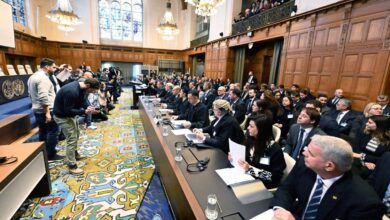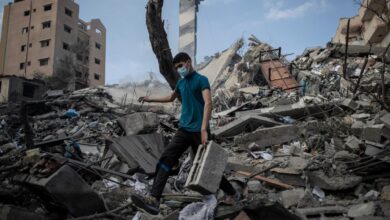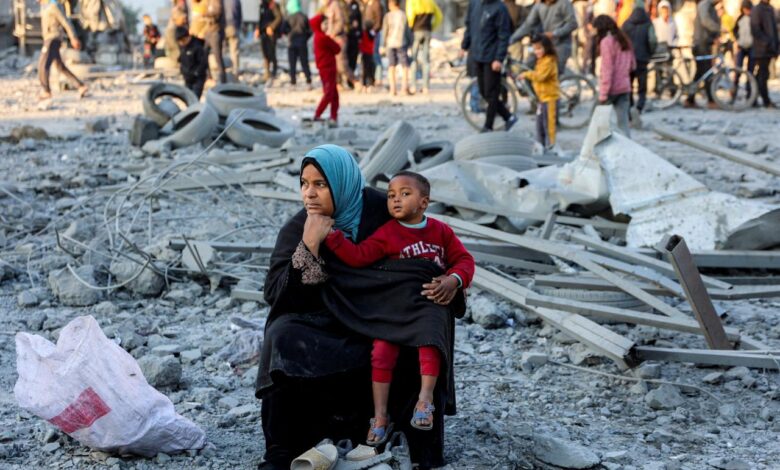
Israel War Ceasefire Talks A Complex Path
Israel war ceasefire talks are underway, a delicate dance between conflicting interests and hopes for peace. This complex negotiation, involving historical grievances, current political pressures, and humanitarian concerns, promises a challenging path toward a resolution. Understanding the intricacies of these talks is crucial for comprehending the potential outcomes and their impact on the region.
The talks encompass a wide range of factors, from the historical context of the Israeli-Palestinian conflict to the current status of negotiations, potential outcomes, international involvement, humanitarian needs, public perceptions, and historical precedents. Analyzing these aspects provides a comprehensive view of the situation and the obstacles to a lasting ceasefire.
Historical Context of Israeli-Palestinian Conflict
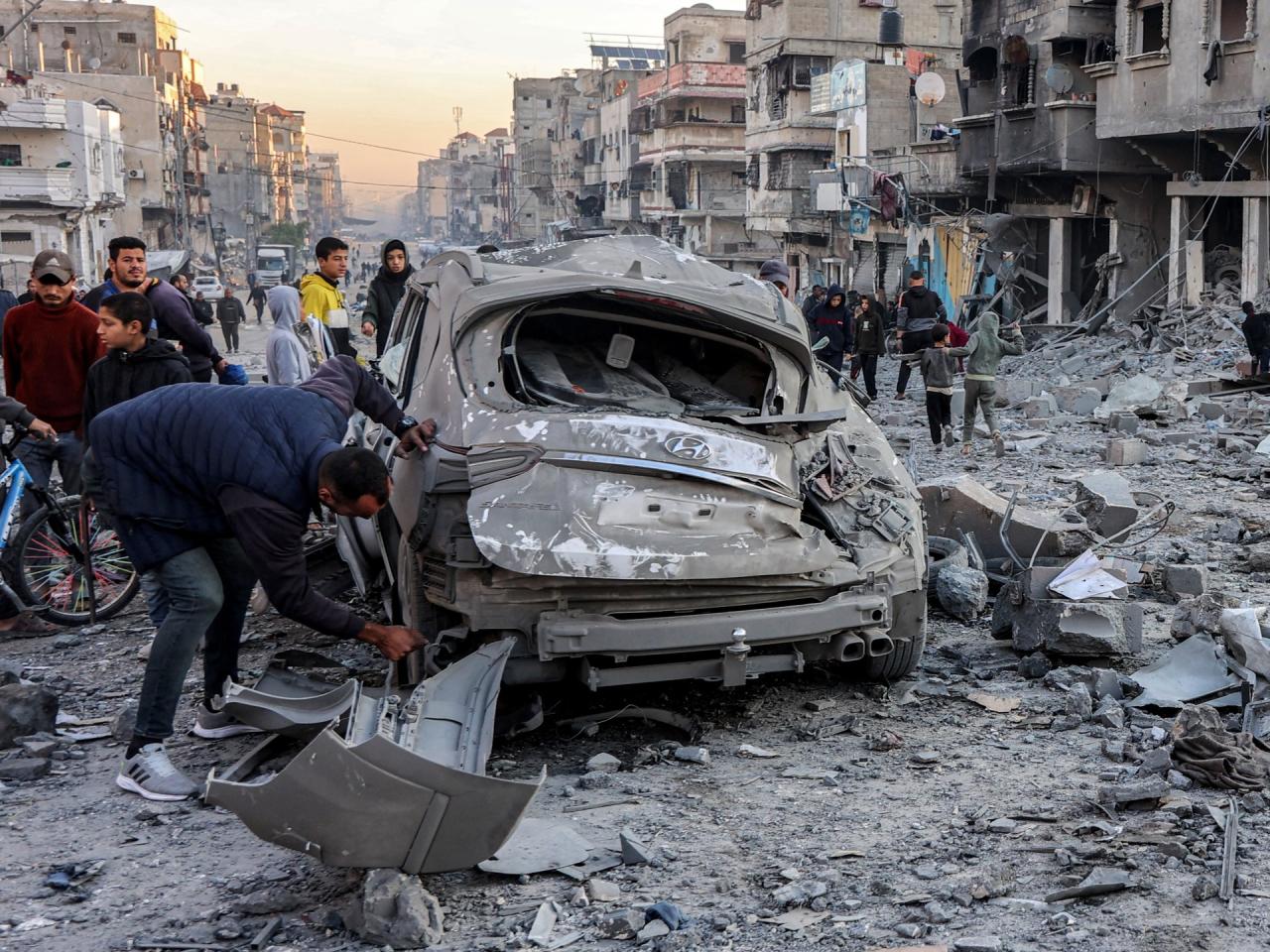
The Israeli-Palestinian conflict, a deeply rooted and complex struggle, has shaped the geopolitical landscape of the Middle East for decades. Its origins lie in competing historical narratives, religious claims, and political aspirations, leading to a cycle of violence and displacement that continues to impact the region today. The current ceasefire talks represent a fragile attempt to navigate this intricate history and seek a lasting resolution.
Key Events and Turning Points
The conflict’s trajectory is marked by a series of events, each with significant consequences for the future. Understanding these pivotal moments provides crucial context for comprehending the current state of affairs.
| Event | Date | Location | Key Actors |
|---|---|---|---|
| Balfour Declaration | 1917 | London, UK | British government, Zionist movement |
| Establishment of the State of Israel | 1948 | British Mandate of Palestine | Israeli government, Arab League states, Palestinian communities |
| 1967 Six-Day War | 1967 | Middle East | Israel, Egypt, Jordan, Syria |
| Oslo Accords | 1993 | Oslo, Norway | Israel, Palestine Liberation Organization (PLO) |
| Second Intifada | 2000 | Palestinian territories | Palestinian militants, Israeli security forces |
Political and Social Factors
The conflict has been profoundly shaped by political and social forces. Zionist aspirations for a Jewish homeland and Palestinian claims to self-determination are central to the conflict. These competing claims have led to the displacement of populations, the division of land, and ongoing conflict.
- Religious Dimensions: The conflict has deep religious roots, with both Israelis and Palestinians claiming historical and religious ties to the land. This often fuels the conflict and complicates any potential resolution.
- Political Motivations: Nationalism, political opportunism, and the pursuit of power have played crucial roles in the conflict’s evolution. These factors have frequently overshadowed efforts toward peaceful coexistence.
- Economic Considerations: The scarcity of resources and the uneven distribution of wealth have contributed to the ongoing tension and conflict. The economic disparities between Israelis and Palestinians have created an environment where violence and mistrust are prevalent.
Different Perspectives
Understanding the various perspectives of stakeholders involved is crucial for grasping the complexity of the conflict.
The Israeli war ceasefire talks are proving incredibly complex, with various factions holding firm on their positions. It’s a stark reminder of the delicate balance needed in such negotiations. Meanwhile, the recent tragedy at Disney World, involving an allergy-related death, highlights the importance of thorough safety protocols in public spaces, like the ones we see in the disney world allergy death lawsuit.
Ultimately, the ongoing Israeli discussions need to find common ground for lasting peace.
- Israeli Perspective: Israelis often emphasize security concerns and the need to protect their population. They cite historical grievances and the right to self-determination in their justification for their actions.
- Palestinian Perspective: Palestinians prioritize the right to self-determination and the establishment of an independent state. They often highlight the historical injustices they have faced and the need for recognition and restitution.
- International Community Perspective: International actors often call for a two-state solution and an end to violence. They advocate for the rights of both Israelis and Palestinians and seek a resolution that respects international law.
Current Status of Ceasefire Talks
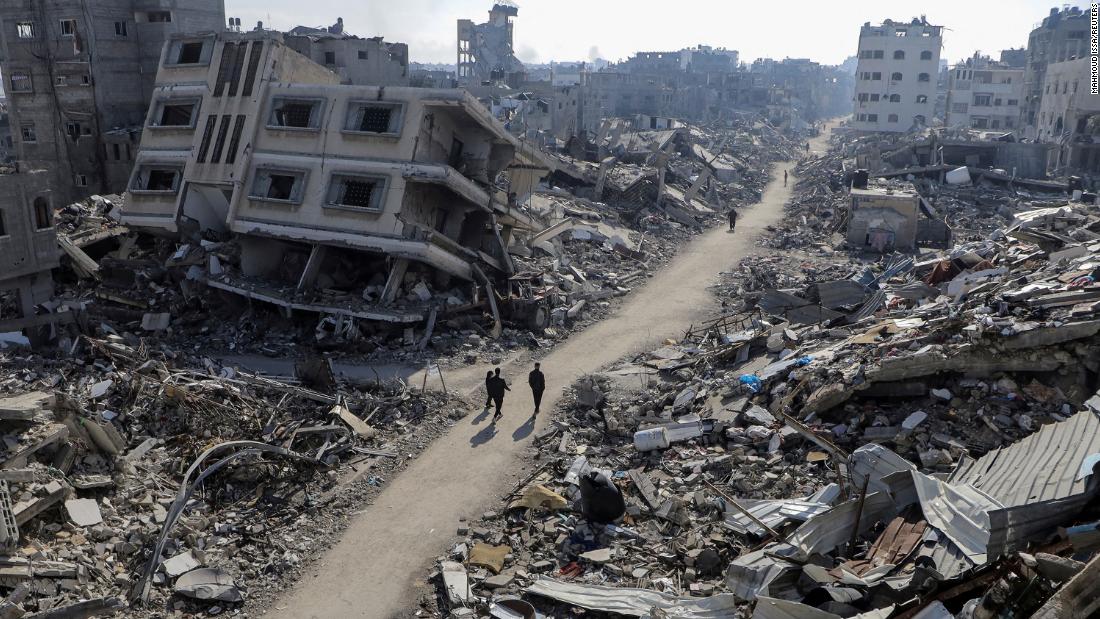
The ongoing Israeli-Palestinian ceasefire talks, a crucial step towards de-escalation, are marked by a delicate balance of hope and skepticism. Recent developments, while not always positive, reflect the persistent efforts of negotiators to find common ground. Understanding the complexities of these negotiations is essential to assessing the prospects for a lasting resolution.The path towards a lasting ceasefire is fraught with historical grievances and deeply entrenched political positions.
The potential for breakthroughs hinges on the ability of key players to navigate these obstacles and find a solution that satisfies the needs of both sides. Significant progress, though, remains elusive.
The Israeli war ceasefire talks are proving incredibly complex, with no easy solutions in sight. While the world holds its breath, it’s interesting to note that the upcoming subway weekend in Jose Lasalle, subway weekend jose lasalle , is likely to be filled with excitement and anticipation, just like the hopes surrounding these crucial negotiations.
Hopefully, the discussions will move forward as quickly and positively as a successful subway weekend in Jose Lasalle. These talks are vital for the region’s future.
Recent Developments and Negotiations
The recent rounds of talks have focused on specific areas of contention, including the release of prisoners, access to resources, and the prevention of further escalation. Negotiations have been characterized by both periods of intense engagement and moments of deadlock. The nature of these negotiations, often conducted behind closed doors, limits public access to detailed information.
Key Negotiators and Their Roles
Several key figures are playing critical roles in these negotiations. These individuals, from both sides, bring a unique combination of diplomatic experience and political acumen to the table. Understanding their individual mandates and priorities is essential to comprehending the complexities of the negotiations. Their backgrounds and political allegiances influence their approaches and objectives.
Obstacles and Challenges to a Lasting Ceasefire
Several significant obstacles hinder the attainment of a lasting ceasefire. These include differing interpretations of past agreements, persistent mistrust between the parties, and the need for long-term security guarantees. Also, external factors such as regional tensions and global geopolitical shifts can also exert pressure on the talks.
Influence on the Outcome of Talks
The interplay of these obstacles, along with the roles of key negotiators and the nature of recent developments, will undoubtedly shape the final outcome of the talks. Past ceasefire agreements, often fragile, offer insights into the challenges of maintaining peace. The success of future agreements will rely heavily on the ability of negotiators to address these concerns and build a foundation of trust.
Major Proposals and Counter-Proposals
| Proposal | Counter-Proposal |
|---|---|
| Release of Palestinian prisoners in exchange for specific security guarantees | Release of prisoners contingent on demonstrable actions to prevent future violence. |
| Increased access to resources for Palestinian communities | Increased access linked to the dismantling of militant groups. |
| Joint security patrols to prevent cross-border incidents | Security patrols under international observation to ensure impartiality. |
These proposals and counter-proposals, while not exhaustive, highlight the areas of disagreement and the complex trade-offs inherent in the negotiations. Each proposal and counter-proposal reflects the distinct interests and priorities of the parties involved.
Potential Outcomes and Implications
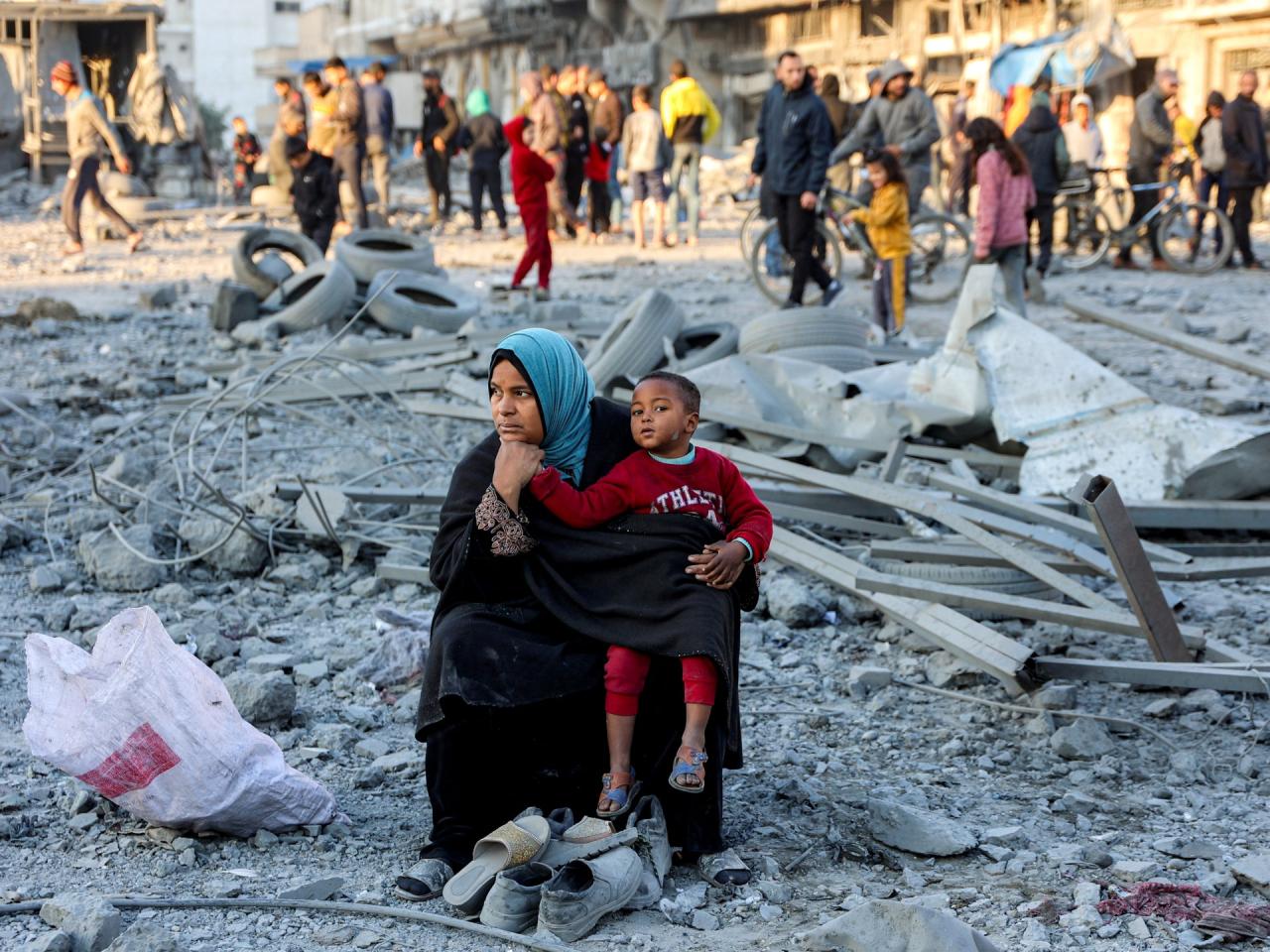
The future of the Israeli-Palestinian conflict hangs precariously in the balance, with the potential for a ceasefire agreement offering both hope and significant challenges. A successful resolution would necessitate a nuanced understanding of the complex historical, political, and social factors at play. The implications extend far beyond the immediate region, impacting regional stability and the daily lives of countless civilians.The potential outcomes of successful ceasefire talks range from short-term stability to long-term peace, dependent on the specifics of the agreement and the commitment of all parties.
The potential for conflict to re-emerge remains, highlighting the delicate nature of the situation. A well-structured ceasefire could lay the groundwork for a lasting resolution, but its success hinges on the willingness of all parties to adhere to the agreed-upon terms and build trust.
Possible Agreements and Resolutions
Successful ceasefire talks could lead to several agreements and resolutions, ranging from immediate reductions in violence to more comprehensive agreements covering various aspects of the conflict. These agreements could include:
- Mutually agreed upon de-escalation zones: This could involve establishing buffer zones or demilitarized areas to reduce the risk of clashes. Past ceasefires have seen similar implementations, albeit with varying degrees of success.
- Shared responsibility for maintaining the ceasefire: This could involve establishing joint monitoring mechanisms and security arrangements, with clear roles and responsibilities for both sides. The success of such mechanisms depends heavily on trust and adherence to the agreements.
- Agreement on prisoner exchanges: This could be a crucial element in reducing tensions and potentially easing humanitarian concerns. Similar prisoner exchanges have occurred in the past, often with complex political implications.
Implications for Regional Stability and Security
A ceasefire agreement, if successfully implemented, could bring about a period of relative calm and stability in the region. This could reduce the risk of wider conflicts and allow for the focus on economic development and humanitarian aid. Conversely, failure to implement the agreement or a return to conflict could destabilize the region further.
- Reduced violence: A ceasefire, if effectively enforced, could significantly reduce the level of violence and the suffering of civilians. A decrease in violence can lead to a more favorable environment for economic development and humanitarian aid distribution.
- Improved relations with neighboring countries: The reduction in conflict could lead to a more favorable climate for diplomacy and cooperation with neighboring countries. Improved relations often translate into enhanced economic and security opportunities.
- Regional cooperation: A stable environment can pave the way for increased regional cooperation on various issues, including economic development and environmental challenges. Such cooperation could provide opportunities for shared prosperity.
Long-Term Consequences
The long-term consequences of a ceasefire agreement could be profound, impacting the lives of civilians for generations to come.
- Positive impact on civilians: A successful ceasefire could result in fewer casualties, less displacement, and improved living conditions for civilians. Reduced violence allows for a greater focus on rebuilding infrastructure and providing essential services.
- Potential for economic development: A peaceful environment can create an environment for economic growth and development, fostering job creation and improved living standards. Historical examples of post-conflict recovery demonstrate the potential for rapid development.
- Negative consequences: The agreement might not address the root causes of the conflict, potentially leading to a resurgence of violence in the future. The success of the agreement relies on the commitment of all parties involved.
Impact on Civilian Lives
A ceasefire agreement’s impact on the lives of civilians in the region would be substantial.
- Reduced casualties: A ceasefire agreement can result in a substantial reduction in casualties, minimizing the loss of life and suffering.
- Improved living conditions: A reduction in violence could allow for a greater focus on humanitarian aid, infrastructure development, and the provision of essential services, leading to improved living conditions for civilians.
- Increased opportunities: Peace and stability create more opportunities for education, employment, and overall economic development for civilians.
Potential Scenarios and Outcomes
The following table illustrates potential scenarios and their corresponding outcomes.
| Scenario | Potential Outcomes |
|---|---|
| Successful Ceasefire and Negotiations | Reduced violence, potential for long-term peace, economic growth, and improved living conditions. |
| Temporary Ceasefire with No Lasting Resolution | Temporary respite from violence, but underlying tensions could resurface, potentially leading to further conflict. |
| Failure to Reach a Ceasefire | Continued violence, displacement, humanitarian crisis, and regional instability. |
International Involvement and Support: Israel War Ceasefire Talks
The Israeli-Palestinian conflict has consistently drawn in international actors, each with their own motivations and approaches. Their involvement in ceasefire talks is crucial, as their influence can significantly impact the success or failure of negotiations. Understanding these dynamics is vital to assessing the potential outcomes and implications of the current talks.International players bring a multitude of perspectives and resources to the table.
Their varied interests, whether geopolitical, humanitarian, or economic, shape their engagement and influence the course of negotiations. Examining these nuances provides insight into the complex interplay of forces at play in the conflict.
Roles of International Actors
Various international actors, including the United Nations, the United States, the European Union, and individual countries like Russia and Egypt, play significant roles in the Israeli-Palestinian conflict. These entities act as mediators, observers, or supporters, providing various forms of assistance and pressure to facilitate a resolution. Their presence and actions significantly impact the atmosphere and direction of the ceasefire talks.
Motivations and Interests of International Players
International actors often have diverse motivations behind their involvement. For instance, the United States, a major power in the region, may be driven by strategic interests related to regional stability and its relationship with Israel. The European Union, prioritizing human rights and security, might focus on promoting a two-state solution. Russia, with its own interests in the region, might approach the conflict from a different angle.
These varied motivations and objectives can lead to differing approaches to conflict resolution.
Comparison of Mediation Approaches
Different international mediators adopt various strategies in their mediation efforts. The United Nations, with its broad mandate, often employs a diplomatic approach, fostering dialogue and encouraging compromises. The United States, often a key player in the negotiations, may employ a more forceful approach, leveraging its influence and bilateral relationships with both parties. Other actors, like the European Union, might prioritize human rights and humanitarian concerns in their mediation efforts.
These contrasting approaches reflect the complex and nuanced nature of the conflict.
Potential Areas of Support and Cooperation
Areas of potential support and cooperation among international actors include financial aid for reconstruction, humanitarian assistance to affected populations, and initiatives to improve the economic conditions of both sides. Joint efforts can enhance the effectiveness of ceasefire talks and pave the way for lasting peace. Successful collaboration requires recognizing common ground and coordinating efforts.
Table of International Actors
| International Actor | Involvement | Potential Influence |
|---|---|---|
| United Nations | Mediation, peacekeeping, humanitarian aid | Significant, as a neutral party |
| United States | Bilateral engagement, pressure on parties | Strong, given its economic and military power |
| European Union | Diplomatic efforts, humanitarian aid | Moderate, focusing on human rights |
| Russia | Engagement with both sides | Variable, influenced by broader geopolitical interests |
| Egypt | Mediation, fostering dialogue | Historically significant in the region |
Humanitarian Concerns and Needs
The Israeli-Palestinian conflict consistently generates immense humanitarian suffering. Displacement, loss of life, and widespread destruction of infrastructure leave a trail of vulnerable populations in need of urgent assistance. Understanding these needs and the resources required to address them is crucial for effective conflict resolution and long-term stability. This section will detail the pressing humanitarian concerns during and after the conflict, and during the ceasefire talks.
Affected Populations’ Needs During Conflict
The conflict’s impact extends far beyond the immediate battle zone, affecting civilians in a wide radius. Displacement of families, loss of livelihoods, and disruption of essential services like healthcare and water create widespread vulnerability. The conflict frequently results in a significant increase in the number of vulnerable individuals and families in need of immediate aid. A major concern is the potential for the spread of infectious diseases due to the disruption of sanitation systems and the lack of access to medical care.
The psychological toll on affected populations, particularly children, is also significant. The trauma of witnessing violence and loss can have lasting effects on mental health and well-being.
The Israel war ceasefire talks are proving incredibly complex, with both sides holding firm on their positions. Meanwhile, the glitz and glamour of Paris Fashion Week is in full swing, with shows like the Saint Laurent Dior Paris fashion week saint laurent dior paris fashion week showcasing stunning designs and captivating collections. Ultimately, though, the focus must remain on the crucial need for a swift and lasting resolution to the ongoing conflict.
Essential Services Required
Addressing the humanitarian needs requires a multi-faceted approach, focusing on essential services. Access to medical care is paramount, as injuries and illnesses increase dramatically during conflicts. The immediate need includes first aid, emergency surgery, and ongoing medical treatment for the wounded. Providing adequate food supplies is also critical, especially for displaced populations who often lose access to their usual sources of sustenance.
Essential supplies such as water and sanitation are critical to preventing disease outbreaks, particularly in crowded or displaced populations. Providing temporary shelter for displaced individuals and families is also essential, particularly for those whose homes have been damaged or destroyed.
The ongoing Israeli war ceasefire talks are a complex web of political maneuvering, but they also highlight the human cost of conflict. The recent tragedy of grief, as seen in the powerful piece “Grief is for people sloane crosley” ( grief is for people sloane crosley ), reminds us that these talks are not just about borders and security, but about the countless lives impacted by war.
Ultimately, successful ceasefire negotiations will require empathy and a deep understanding of the profound suffering, and the hope for a future free from violence.
Impact on Displaced Populations, Israel war ceasefire talks
Displaced populations face unique challenges during and after conflict. The loss of homes, livelihoods, and community ties can lead to severe psychological distress and economic hardship. Displacement often results in overcrowding in temporary shelters, further exacerbating existing vulnerabilities. Lack of access to basic necessities like food, water, and sanitation can have severe consequences, increasing the risk of disease and malnutrition.
The disruption of education for children is another serious concern. Displacement frequently leads to lost school years and decreased opportunities for future development.
Summary of Humanitarian Needs and Aid Organizations
| Humanitarian Need | Description | Organizations Providing Aid |
|---|---|---|
| Medical Care | Emergency treatment, ongoing medical care for injuries and illnesses. | Doctors Without Borders, Médecins Sans Frontières, Red Cross, various national medical organizations. |
| Food Security | Provision of essential food supplies for affected populations, particularly displaced persons. | World Food Programme, local NGOs, various humanitarian organizations. |
| Shelter | Provision of temporary housing and support for displaced populations. | UNHCR, local NGOs, aid agencies with expertise in emergency shelter. |
| Water and Sanitation | Ensuring access to clean water and sanitation facilities to prevent disease outbreaks. | WaterAid, UNICEF, various international organizations specializing in water and sanitation. |
| Psychosocial Support | Addressing the psychological impact of conflict on individuals and families, especially children. | International Rescue Committee, local NGOs, mental health professionals. |
Public Opinion and Perceptions
Public perception plays a crucial role in shaping the trajectory of the Israeli-Palestinian conflict and the success or failure of any ceasefire talks. Understanding the diverse narratives and anxieties held by individuals on both sides is essential to comprehending the complex dynamics at play. Public opinion often influences political decisions, shaping public support for or against peace initiatives.
The Israeli war ceasefire talks are a complex issue, demanding careful consideration of all sides. While the focus remains on diplomatic solutions, it’s crucial to remember the importance of preventative measures, like understanding condon prevencion vih sida for a healthier future. Ultimately, the path to lasting peace in the region depends on a multifaceted approach that prioritizes both immediate needs and long-term strategies.
It can also contribute to the escalation or de-escalation of tensions.Analyzing public perceptions requires considering the deeply entrenched historical grievances, cultural differences, and media portrayals that have shaped public discourse. These factors contribute to the formation of distinct narratives that often clash, hindering progress toward a peaceful resolution. It is imperative to acknowledge the emotional and historical contexts that underpin these differing views.
Public Narratives in Israeli Media
Israeli media outlets frequently highlight security concerns and the need to protect Israeli citizens from attacks. The narrative often emphasizes the Palestinian rejection of peace and the need for continued vigilance. There is a strong emphasis on the historical context of the conflict, often portraying Israel as a victim of aggression and Palestinian terrorism. Some outlets may present a more nuanced perspective, acknowledging the complexities of the situation and the need for a two-state solution.
Public Narratives in Palestinian Media
Palestinian media outlets often emphasize the occupation, human rights violations, and the struggle for self-determination. The narrative frequently portrays Israel as the aggressor and a barrier to Palestinian statehood. The focus often centers on the need for a complete end to the occupation and the establishment of an independent Palestinian state. Some outlets may present a more moderate perspective, advocating for peaceful resolutions and negotiation.
Comparative Analysis of Media Portrayals
The contrasting narratives in Israeli and Palestinian media are evident in the ways the conflict is framed and presented.
| Country | Media Outlet | Prevailing Narrative |
|---|---|---|
| Israel | Channel 13 News | Focuses on security concerns, portraying Palestinian groups as a threat to Israeli citizens and emphasizing the historical context of the conflict, often highlighting the need for continued vigilance. |
| Israel | Ynetnews | Often presents a hawkish perspective on the conflict, highlighting alleged Palestinian rejection of peace proposals and emphasizing the need for Israel’s security. |
| Palestine | Al Jazeera | Emphasizes the occupation, human rights abuses, and the Palestinian struggle for self-determination. Often portrays Israel as the aggressor and a barrier to Palestinian statehood. |
| Palestine | Palestine News Network | Focuses on the Palestinian perspective, emphasizing the need for a complete end to the occupation and the establishment of an independent Palestinian state. |
Public Expectations and Concerns
Public expectations regarding the ceasefire talks vary widely. Some Israelis may expect a quick resolution that ensures their safety, while others may be more cautious and wary of potential compromises. Palestinians may hope for concrete steps toward independence and an end to the occupation, while others may be skeptical of the intentions of Israeli authorities. Both sides have concerns about the future and the well-being of their respective communities.
These expectations and concerns are often deeply rooted in historical experiences and cultural values.
Historical Precedents of Ceasefires
The Israeli-Palestinian conflict is marked by cycles of violence and fragile peace agreements. Understanding past ceasefire attempts, their successes and failures, is crucial for navigating the complexities of the current negotiations. Analyzing historical precedents can offer valuable insights, potentially illuminating pathways towards more durable solutions.Examining past ceasefires reveals patterns, both positive and negative, that can help shape expectations and strategies for the current talks.
Lessons learned from these experiences can be applied to the current situation, helping to anticipate potential pitfalls and explore opportunities for lasting peace. This analysis is not about replicating past models but about extracting the essence of what worked and what didn’t, in order to inform the present.
Examples of Past Ceasefire Agreements
Various ceasefires have been attempted throughout history, often with mixed results. Understanding the specifics of these agreements, and the circumstances surrounding their success or failure, can shed light on the factors crucial for a lasting peace.
- The 1973 ceasefire in the Yom Kippur War, while ending active hostilities, ultimately did not resolve the underlying issues that led to the conflict. The ceasefire, brokered by the UN, demonstrated the power of international intervention in halting immediate violence, but it failed to address the root causes of the dispute. This highlights the need for a comprehensive approach, beyond mere cessation of fighting.
- The 1991 Gulf War ceasefire, negotiated under UN auspices, provided a clear example of a negotiated end to hostilities. This agreement was notable for the relatively swift implementation and the clear mandate from the international community. The effectiveness of this agreement, however, is contextualized by the specific circumstances of the conflict, and the presence of a clear aggressor. This underscores the need for careful consideration of the specific context of the conflict in assessing the viability of a ceasefire.
Factors Contributing to Success or Failure
The success or failure of a ceasefire is often influenced by several key factors. Analyzing these factors provides a framework for understanding the complexities of peace negotiations.
- International Involvement and Support: The degree of commitment and active involvement from international actors significantly impacts the stability of a ceasefire. Robust support from the international community can provide a crucial framework for implementation and enforcement, potentially facilitating a more durable peace. The absence of such support can lead to a lack of accountability and ultimately contribute to the failure of the agreement.
- Underlying Issues: A ceasefire alone rarely resolves the fundamental causes of conflict. A true resolution requires addressing issues such as political grievances, territorial disputes, and economic disparities. If these underlying issues are not addressed, the ceasefire may be fragile and prone to relapse into violence. A ceasefire without addressing these issues risks only postponing the conflict, rather than resolving it.
- Implementation and Enforcement Mechanisms: The effectiveness of a ceasefire depends on robust implementation and enforcement mechanisms. Clear agreements on the roles and responsibilities of all parties involved, along with monitoring and verification procedures, are crucial for ensuring compliance and preventing future escalations. The absence of such mechanisms often leads to violations, eroding trust and undermining the ceasefire’s credibility.
Lessons Learned from Past Experiences
Past experiences with ceasefires provide crucial lessons for the current negotiations. Recognizing these lessons can guide the parties towards more sustainable outcomes.
- The importance of addressing root causes, not just immediate hostilities. A ceasefire without tackling the underlying issues of conflict is unlikely to endure.
- The necessity of international involvement and support. External actors can play a vital role in facilitating compliance and ensuring the longevity of a ceasefire agreement.
- The significance of strong enforcement mechanisms. Clear protocols and robust monitoring are essential to deter future violations and ensure the ceasefire’s integrity.
Comparative Analysis of Past Ceasefire Agreements
A comparative analysis of past ceasefires offers a structured view of their similarities and differences. The table below provides a snapshot of several key agreements, highlighting their successes and failures.
| Ceasefire Agreement | Successes | Failures | Key Lessons |
|---|---|---|---|
| Yom Kippur War Ceasefire (1973) | Ended active hostilities | Failed to address underlying issues | Addressing root causes is essential for lasting peace. |
| Gulf War Ceasefire (1991) | Swift implementation | Context-specific success; may not be replicable | International involvement and clear mandate are crucial. |
| [Add more agreements here] | [Add details of successes] | [Add details of failures] | [Add key lessons learned] |
Final Review
In conclusion, the Israel war ceasefire talks represent a crucial moment for the region. While the path to a lasting resolution is fraught with challenges, the ongoing negotiations offer a glimmer of hope for a future where peace and stability can prevail. The potential outcomes, both positive and negative, will significantly impact the lives of civilians and the regional landscape.
Ultimately, the success of these talks will hinge on the willingness of all parties to compromise and find common ground.
Quick FAQs
What are the key obstacles to reaching a lasting ceasefire?
Significant obstacles include differing political agendas, security concerns, and historical grievances. Trust-building between the involved parties is essential, but deep-seated mistrust and unresolved conflicts from the past remain major challenges.
What are the humanitarian needs of affected populations during the conflict and ceasefire talks?
Essential services like medical care, food, shelter, and clean water are critically needed for those affected by the conflict. Displaced populations require support for resettlement and recovery.
How might past ceasefire agreements inform the current negotiations?
Analyzing past successes and failures provides valuable lessons about the complexities of negotiation and the need for compromise. Understanding these precedents can help inform strategies for a more sustainable outcome in the current talks.
What role do international actors play in the ceasefire talks?
International actors, such as the UN and other mediators, play crucial roles in facilitating communication and encouraging compromise between the parties involved. Their influence can significantly impact the outcome of the talks.

